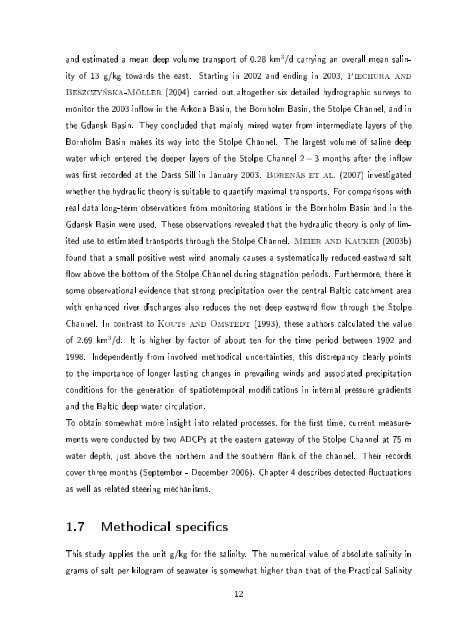Baltic Sea
Baltic Sea
Baltic Sea
You also want an ePaper? Increase the reach of your titles
YUMPU automatically turns print PDFs into web optimized ePapers that Google loves.
and estimated a mean deep volume transport of 0.28 km 3 /d carrying an overall mean salinity<br />
of 13 g/kg towards the east. Starting in 2002 and ending in 2003, Piechura and<br />
Beszczy«ska-Möller (2004) carried out altogether six detailed hydrographic surveys to<br />
monitor the 2003 inow in the Arkona Basin, the Bornholm Basin, the Stolpe Channel, and in<br />
the Gdansk Basin. They concluded that mainly mixed water from intermediate layers of the<br />
Bornholm Basin makes its way into the Stolpe Channel. The largest volume of saline deep<br />
water which entered the deeper layers of the Stolpe Channel 2 − 3 months after the inow<br />
was rst recorded at the Darss Sill in January 2003. Borenäs et al. (2007) investigated<br />
whether the hydraulic theory is suitable to quantify maximal transports. For comparisons with<br />
real data long-term observations from monitoring stations in the Bornholm Basin and in the<br />
Gdansk Basin were used. These observations revealed that the hydraulic theory is only of limited<br />
use to estimated transports through the Stolpe Channel. Meier and Kauker (2003b)<br />
found that a small positive west wind anomaly causes a systematically reduced eastward salt<br />
ow above the bottom of the Stolpe Channel during stagnation periods. Furthermore, there is<br />
some observational evidence that strong precipitation over the central <strong>Baltic</strong> catchment area<br />
with enhanced river discharges also reduces the net deep eastward ow through the Stolpe<br />
Channel. In contrast to Kouts and Omstedt (1993), these authors calculated the value<br />
of 2.69 km 3 /d. It is higher by factor of about ten for the time period between 1902 and<br />
1998. Independently from involved methodical uncertainties, this discrepancy clearly points<br />
to the importance of longer lasting changes in prevailing winds and associated precipitation<br />
conditions for the generation of spatiotemporal modications in internal pressure gradients<br />
and the <strong>Baltic</strong> deep water circulation.<br />
To obtain somewhat more insight into related processes, for the rst time, current measurements<br />
were conducted by two ADCPs at the eastern gateway of the Stolpe Channel at 75 m<br />
water depth, just above the northern and the southern ank of the channel. Their records<br />
cover three months (September - December 2006). Chapter 4 describes detected uctuations<br />
as well as related steering mechanisms.<br />
1.7 Methodical specics<br />
This study applies the unit g/kg for the salinity. The numerical value of absolute salinity in<br />
grams of salt per kilogram of seawater is somewhat higher than that of the Practical Salinity<br />
12



